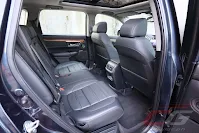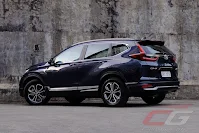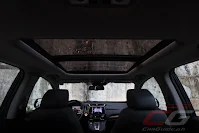Once in a while, it’s good to be reminded that some cars remain at the forefront of their respective segments despite the presence or allure of newer, snazzier competition. Our reacquaintance with the CR-V over a week is a prime example of that.
Introduced way back in 2017, the current-generation CR-V is considered the senior citizen in the compact SUV space. Despite some little issues, we found the experience to be overwhelmingly positive to the point that we made it our Top Pick for that year.
Since then, newer offerings came out, and the local market even saw the proliferation of Chinese-made SUVs. A refresh in 2020 (for the 2021 model year) managed to keep the CR-V fresh. However, because the changes are mainly aesthetic, where does the top-trim CR-V SX Diesel now lie in the 2021 pecking order.
Let’s start with the CR-V’s biggest miss: the powertrain. Despite the paltry 120 horsepower output, the 1.6-liter turbocharged diesel engine is okay, if only just. Left in the confines of the city and the miserable traffic, it makes use of its stout 300 Nm of torque to give it a feel akin to a large displacement gasoline. It’s also smooth, refined, and for a diesel, quiet. Being sensible with the throttle also helps it return pretty solid fuel economy figures: 15.5 km/L.
So, what’s wrong? Well, Honda could have given us more driving excitement by giving the CR-V a much-needed power boost. With its competitors all jockeying on power and torque, the CR-V’s i-DTEC engine is left with the same output as a Honda City or BR-V. And this thing weighs an odd 300 to 400 kilograms more. Weirdly enough, the carmaker won’t have to look that far. The same engine, albeit with a two-stage turbocharger is available in Thailand and that one makes 160 horsepower (up 40 horsepower) and 350 Nm (up 50 Nm) over our version.
During its 2017 launch, Honda’s product planning team said they opted for the low output diesel because of “specific market targets in both driving dynamics and fuel efficiency.” That was well and good then. But guys, it’s 2021 and buyers want more power (no need to FGD that). The CR-V missed the boat on this one.
Another aspect where the CR-V is starting to show its age is with its infotainment system. Four years ago, the system looked and operated great. It even offered a physical volume knob, something that was missing in the then-new tenth generation Civic. But boy, it hasn’t aged well. Today, the system looks haggard and is laggy. Touchscreen presses require what feel like an eternity of wait before it switches over to the next screen. It gets frustrating after a while.
For 2021, the CR-V also adds wireless charging which is great in principle. In practice though, it’s pretty useless. The pad is located on a smooth, flat plane which requires the phone to be placed directly on top of it to work. The moment your phone slides off the pad (and it does so even at parking lot speeds), the charging stops. Oh, and given that the CarPlay isn’t wireless and the USB ports are located in front of the wireless charger, most will plug just in the old-fashioned way.
Oddly enough, the controversial push button shifter feels less awkward now than before. Having to press buttons does take some getting used to, but this becomes second nature after a while (even when doing a three-point turn). What’s difficult to adjust to is the one-second delay the electronics needs to move from gear to gear. Sometimes, it makes you double check if you selected the right gear or not. This, and the lack of visual cues to the status of the electronic parking brake (save for a small indicator light on the dashboard) should be on top of the CR-V’s must dos during the next full model change.
These issues aside, the CR-V maintains its position as a sensible family-friendly choice. Despite being classified as a compact SUV, the CR-V’s interior space is still the segment’s best. Without a doubt, the front passengers are treated the best with all the room they could ever need. The rest though will have to learn how to share. Space in the third row is largely dependent on how much legroom those in the second row would be willing to give back. They can opt to get economy class legroom to fit 7 adults or decide to go business class and amputate the legs of those in the back. Aside from seating flexibility, the CR-V is pretty clever too. There’s an abundance of storage spaces across all rows (including a clever re-configurable center console) and even a two-level rear package shelf.
In terms of design, there’s no faulting it. The new bumper gives it a stronger and more athletic flair, but it doesn’t change the overall look and feel. The standard roof rails are welcome, not because I’m the outdoorsy type but because it makes the roof easier to wash (I use it as grab handles). Thanks, Honda. The SX Diesel also adds sequential turn signal lights at the front and a power tailgate with a kick sensor at the back. These features won’t have you wowing, but at least they’re there.
Honda’s also kept the CR-V’s under bits unchanged. Thus, it doesn’t really excite, but it does return a well-sorted driving experience. The ride is smooth and it offers good straight-line stability. Take note: it’s really more focused on bringing you to your destination in comfort rather than how it’ll please you on the next corner. You want a compact SUV that’s fun to drive? The CR-V’s not for you.
Having said that, at least the CR-V’s really embracing its family-oriented nature by getting Honda SENSING (at least on some trims). It contains systems such as collision mitigation, lane- and road-departure mitigation, active cruise control, and lane-keeping assist. Weirdly, all its collision avoidance technology seem to be front-facing. There’s no blind spot warning or rear cross traffic alert here. Instead, it gets LaneWatch which display an image (albeit a pixelated one) from the right side of the car on the central LCD screen.
Four years on, the Honda CR-V remains a sensible, but bland choice in the compact SUV segment. The vast majority of buyers, especially those looking for comfort, space, refinement, and of course, the flexibility offered by the 7-seat layout need not look any further. However, as a whole, there’s this gnawing feeling that Honda just erred on the side of caution with this update. The CR-V is good, but it could have been better.


























Thanks for this honest review, direct to the point!
ReplyDeleteIt's still the only one that combines the practicality of a diesel 7 seater yet has the drive of a small SUV. Goes to show what the buyers of this segment value (not everyone wants a fast family car, some just need a solid, comfortable and practical vehicle).
ReplyDeleteunderpowered and too short for 7 seater. Yaaks
ReplyDeleteYaaks ka dyan lol
DeleteNa-drive mo na? Meron ka?
DeleteKasi na-drive ko na pero di ko feel na underpowered dahil di naman na ako kumakarera eh. Mas magaan pa nga i-drive kesa sa Fortuner namin at Forester namin. Tapos too short for 7-seater? Nagkasya kami 8 kami.
Imagine paying 2.2M+ for a 120hp car. Only Honda ricer fanbois would be that gullible.
ReplyDeleteI imagine paying that much for the torque of a diesel, the safety equipment it has that puts bulky SUVs to shame, and the flexibility.
DeleteOnly Anti-Honda trolls would hate this.
^ Fanboi spotted and hurt lol
Delete2 million for 120 hp is pathetic
Delete